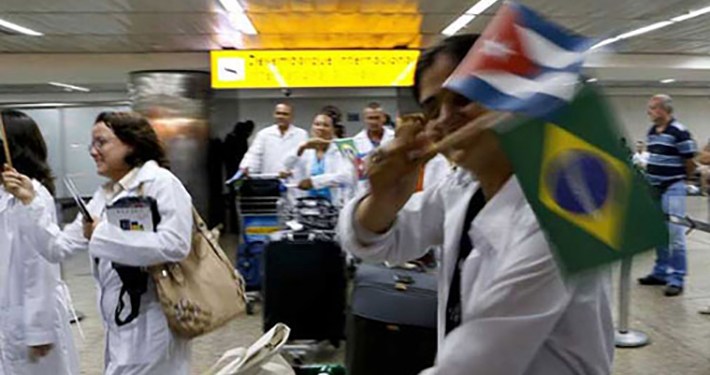 Photo by rawpixel.com from Pexels
Photo by rawpixel.com from Pexels
Does Cuba have alternatives to the sale of medical services?
HAVANA – The withdrawal of Cuban doctors from Brazil does not bode well for any side in this matter. Of course, unless you consider those groups that celebrate anything that imposes additional restrictions on Cuba’s economy. In this case it is another situation they will promote as another example of the failure of the Island’s economic model.
Brazilians who became used to the medical attention offered by Cuban doctors will be concerned with their departure, and wonder who will replace them. Also, Cuban doctors and their families will lose the possibility of jobs that pay them higher wages, which allows them to improve their living standards. And the Cuban government loses its second largest market for medical services — a source of significant income that highly valued under the current economic situation where the country suffers from the decrease in external revenues and is faced with a very complex situation in its international finances.
All this because of the Nov. 14 announcement by the Cuban government that it was terminating the presence of Cuban doctors in Brazil. Through the “Mais Medicos” program, contracted by former Brazilian president Dilma Rousseff in 2013, More Doctors was to improve the medical attention received by Brazilians through the Unified Health System, especially in areas where health care was practically nonexistent. The participation of Cuban doctors was made possible through a technical cooperation project between the Pan American Health Organization (PAHO), the World Health Organization (WHO) and the Ministries of Health of Brazil and Cuba. In the end Cubans represented almost two-thirds of the total professionals hired.
In this column I will not discuss the merits and weaknesses of the decision made by the Cuban authorities. It is worth noting, though, that the position assumed by Brazil’s president-elect did not offer the possibility of a serious renegotiation of the agreement that was initially signed. I will also not delve into the terms of the agreement and its meaning for Cuban professionals. Only they can determine the relevance of the conditions received, and through the organization that represent them seek the modification of sections of the agreement that do not meet their expectations.
The provision of medical services on a large scale, mainly by sending professionals (mode four, according to the World Trade Organization classification) became the most important chapter of Cuban exports since the middle of the last decade. The first major agreement was signed with Venezuela, and through the “Mais Médicos” program, Brazil became the second destination in 2013. Payments received through the latter are liquid resources, while in the case of Venezuela, an exchange has been established that values jointly the services provided by Cuba and the import of oil from that country.
The agreement is one where the Brazilian government pays for the services provided by Cuban personnel, of which a considerable part is channeled directly to the Cuban government. What remains goes to the Cuban health professionals. The annual Brazilian transfers to Cuba are estimated to be around $250 million to $300 million.
What may be an appropriate discussion is an economic strategy in which the export of services with these characteristics has become a key element. This relatively recent new “export specialization” for Cuba, has important implications for its projection of economic development for the present and future development of the nation. In 2017, services accounted for almost 81% of total exports, a notable change compared to 1990, when they were 10%. However, we should also consider that a good part of this was a result of the collapse of the shipment of goods (sugar, nickel, tobacco, medicines), which have increased 2.8% annually since 1994, less than half of the rhythm of the rest of the world. Costa Rica, with a population that is 42% less than Cuba’s, exported four times more goods than Cuba in 2017.
Between 1994 and 2004, facing a very hostile external scenario that included the effects on international tourism because of the 9/11 attacks, the Cuban GDP (according to official figures) grew an average of 3.2%. Between 2005 and last year, at a time when the export of “professional” services began, GDP grew at 3.6% — not a big difference when you take into account that tourism continued to grow during this period, especially after 2014 (the Obama rapprochement) when tourism grew at a relatively high rate. But since 2014, sales of professional services have been decreasing annually.
Where there is a difference is in the ability of these services to stimulate economic activity at home through productive chains and other spillovers. Studies confirm that this export capacity has been systematically weakening since 1985, coinciding with the replacement of the sugar industry as the main export item, first by the increase of international tourism and then by professional services. Although tourism did not become the “locomotive” that many predicted it would be (especially due to deficiencies in the domestic economic fabric), these services produce much less than expected.
Since its inception the take-off of medical services has been linked to contracts negotiated as part of government to government agreements where political harmony has been a central element. This has been beneficial in certain aspects. For example, it guarantees large volumes and immediacy in the implementation. In addition, it has the guarantee of the fiscal resources of the country of destination, and the governmental support that allows it to overcome regulatory obstacles with relative ease. It was at the time a great opportunity because it monetized the large investment in medical training that the country had made since the Sixties. It was also coherent with a certain style of conceiving development, given that these deals allow the Cuban State to keep most of the income generated that can then be used to carry out its economic and social development agenda.
However, this system exhibits several weaknesses that makes me question its true contribution to the long-term development of the nation. First, as it has shown in recent years, it is a high risk strategy. Since it depends on attuned politics and fiscal resources, they are highly vulnerable to political and economic crises. Unfortunately, the two main markets for Cuba have been affected by a combination of both since, at least, 2013. In addition, the standardized and uniform provision of these services by a single Cuban entity significantly limits the possibility of revealing the true advantages of the service lent, and the generation of commercial capacities that would allow the penetration of other markets in competitive conditions. A solution based on the prevailing market rules would constitute a guarantee in terms of the sustainability of the relationship.
With the current structure, and considering activities such as professional services, tobacco, nickel, and pharmaceuticals, it can be estimated that 5% of Cuban workers are linked to 66% of the country’s exports. This represents a huge distortion in terms of the exploitation of the country’s production capacities.
Unfortunately, the latest economic policy initiatives do not favor creating an environment that stimulates domestic productive activity. The additional restrictions on self-employed and cooperative work will only aggravate this contradiction, incompatible with the construction of a prosperous country.
Today Cuba has one of the lowest per capita export rates in Latin America, which has a lot to do with its recurrent balance of payments problem. In the shadow of a model that has evident difficulties offering quality employment opportunities to a large number of its workers, phenomena such as the informal economy, cross-border contraband, and emigration grows. Also, the apparent need of the Cuban authorities to directly control all sources of external revenue does not help.
The strategy has not worked so far. Perhaps it is time to consider other alternatives.


